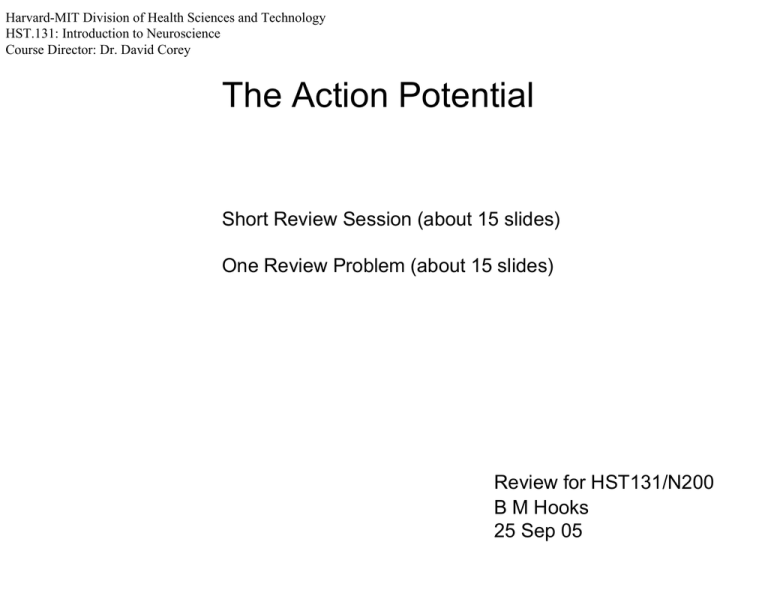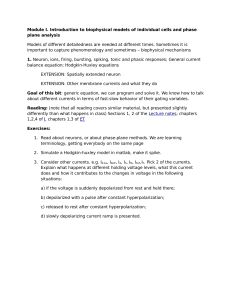Harvard-MIT Division of Health Sciences and Technology HST.131: Introduction to Neuroscience
advertisement

Harvard-MIT Division of Health Sciences and Technology HST.131: Introduction to Neuroscience Course Director: Dr. David Corey The Action Potential Short Review Session (about 15 slides) One Review Problem (about 15 slides) Review for HST131/N200 B M Hooks 25 Sep 05 The Generic HST130/N200 Exam Four Pieces of Advice from Mac: (1) Write your name on EVERY page. (2) Short answer means SHORT answer. (space provided) (3) Leave no questions blank (unless you intend to) (4) Multiple choice: Circle ALL that apply … versus … Circle THE BEST answer Example: Chromosomes contain which of the following? Circle ALL that apply: a. Protein b. Nucleic Acid c. Obi-Wan Kenobi d. Lipid rafts Last Bit of Advice Please study hard for the exam. It will be difficult. The questions will address a variety of levels of knowledge, ranging from the very general (which everyone will know) to the very specific (which fewer people will know). The exam is intended to be challenging, making it unlikely that everyone will have a perfect score. Material and Gratuitous Neuroanatomy Plug Our material in the first block is somewhat less clinical and more basic science that that which follows in neuroanatomy. (HST) Neuroanatomy will have a rapid pace and cover a lot of material: -Please do a good job the lab assignments, as they aid understanding of the material and the lab -The first neuroanatomy lab has an assignment and may occur on the Friday following the exam. How Does Myelin Affect Conduction Velocity? Length Constant: λ = √rm/ri rm = Rm/2πa ri = Ri/πa2 cm = Cm2πa Velocity: v (proportional to) √(aD)/(2RiCm) D = Channel Density The basic Action Potential drawing ENa+ Voltage +50 0 -75 -80 VRest EK+ 0 1 Time (ms) 2 The basic gates drawing for sodium currents Probability 1.0 m3 gates 0.5 h gates 0.0 -100 -50 +50 0 Membrane Potential (mV) +100 Voltage Protocol (“Experiment”) to Test Threshold Voltage +50 ENa+ 0 VRest EK+ -75 -80 Current 0 1 Time (ms) Vary Current or … 2 Voltage Protocol (“Experiment”) to Test Threshold Voltage +50 ENa+ 0 VRest EK+ -75 -80 1 Time (ms) Current 0 Vary Time 2 What’s Happening at Each Point of the AP? Reaching Threshold: -Depolarization causes opening of Na+ channels -Channels are available at rest (rescued from inactivation) -Kinetics of m3, h, and n4 gates -Opening of Na+ channels causes more depolarization (POSITIVE FEEDBACK) Voltage +50 0 -Currents are small initially (few open channels but big driving force) -75 -80 -Currents are get bigger (more open channels and still big driving force) 0 1 Time (ms) 2 What’s Happening at Each Point of the AP? Reaching Threshold: -State of Na+ channels at rest is key (see refractory) Voltage +50 -Idea of charge transfer (during current injection): V=Q/C And Q=I*(time) 0 -75 -80 0 1 Time (ms) 2 What’s Happening at Each Point of the AP? Reaching Peak: -Many Na+ channels open -Kinetics of m3, h, and n4 gates: Delayed rectifiers still not yet on Inactivation begins to close channels Voltage +50 0 -Currents are small initially (many open channels but small driving force) Note: from the APSIM model, we see that K+ current is not as important as Na+ inactivation. -75 -80 0 1 Time (ms) 2 What’s Happening at Each Point of the AP? Repolarization: Three currents flow: -Leak currents (constant) -Na+ currents (inactivating) These two are reponsible for the beginning of the falling phase of the AP And -K+ currents These are slow to activate and so become significant later during the falling phase. Voltage +50 0 -75 -80 0 (Slowing inactivation and separately modifying K+ conductance (but keep Vrest the same!) in APSIM shows 1 the importance of2 inactivation.) Time (ms) What’s Happening at Each Point of the AP? Voltage +50 Afterhyperpolarization: Only two currents remain: -Na+ is inactivated (slow recovery) -Leak currents -K+ delayed rectifier currents These actually keep potential below rest (since they increase the fraction of K+ selective open channels). 0 Vm = gNaENa + gKEK + … gTOT -75 -80 0 1 Time (ms) 2 Voltage Protocol to Test Refractory ENa+ Voltage +50 0 -75 -80 VRest EK+ Current 0 1 Time (ms) Vary Interstimulus Interval 2 What’s Happening at Each Point of the AP? Refractory Period: -Na+ conductances: Recover from inactivation (but slowly) -K+ conductances: Deactivate (also slowly) -Leak conductances: Constant (thus, slow return to rest) Voltage +50 0 Thus, “initial conditions” of available channels are different! -75 -80 0 1 Time (ms) 2 Sample Question: A voltage clamp experiment was performed in which a neuron was stepped from –80 mV to 0 mV and then back to –80 mV (the protocols are shown). The P(V) curves for the “m3” gate and “h” gate are shown below. The time constants of activation and inactivation are 0.5 and 5 msec, respectively. Probability 1.0 m3 gates 0.5 h gates 0.0 -100 -50 +50 0 Membrane Potential (mV) +100 How study sodium current alone? Voltage Current Draw the sodium current in response to the following voltage steps. Assume peak Na+ conductance is 120nS and reversal potential for sodium is +40mV: 0 -80 0 10 Time (ms) 20 0 10 Time (ms) 20 Potentially Helpful Equations: I = Nchannels * γchannel * Popen * (Vm - Vreversal) I = Gmax * Popen * (Vm - Vreversal) And, if Popen = 1.0, then I=Imax: Imax = Gmax * (Vm - Vreversal) Voltage Current Determine peak Na+ current using I=V/R=VG. At 0mV, -40mV driving force and 120nS conductance. Imax=-4.8nA. (Negative since Na+ will be inward current.) At -80mV, -120mV driving force and 120nS conductance. Imax=-14.4nA. 0 -80 0 10 Time (ms) 20 0 10 Time (ms) 20 Voltage Current Determine initial current. Since we assume the clamp has been at -80mV for a long time before the recording, h gates are all open (P=1.0) and m3 gate are all closed (P=0.0). Thus, open probability is zero and there is no current. 0 -80 0 10 Time (ms) 20 0 10 Time (ms) 20 Exponential Function Now step to +0mV. The steady state open probability is about 1.0 for m3 and 0.0 for h gates. However, it will take a certain amount of time to reach these probabilities. -Using the time constant, we see that, after 1ms is: 2 time constants for m3 (so 1-e-t/tau = 1-e-2 = 0.86) and 1/5th time constants for h (so e-t/tau = e-0.2 = 0.81). -Thus, Popen at 1ms is (0.86)*(0.81)=.70 B F(t)=B+(A-B)(e-t/tau) From the graph, we take: For m3, A=0 and B=1. For h, A=1 and B=0. A 5 0 Time (in time constants) 1 tau = 63% 2 tau = 86% 5 tau = 99% Exponential Function Now step to +0mV. Use a similar strategy for 20ms. The steady state open probability is about 1.0 for m3 and 0.0 for h gates. However, it will take a certain amount of time to reach these probabilities. -Using the time constant, we see that, after 20ms is: 40 time constants for m3 (so 1-e-t/tau = 1-e-40 = 1.00) and 4 time constants for h (so e-t/tau = e-4 = 0.02). -Thus, Popen at 1ms is (1.00)*(0.02)=.02 B F(t)=B+(A-B)(e-t/tau) From the graph, we take: For m3, A=0 and B=1. For h, A=1 and B=0. A 5 0 Time (in time constants) 1 tau = 63% 2 tau = 86% 5 tau = 99% Update plot for maximal currents and calculated currents at three time points: t=0ms: 0.00 of max t=1ms: 0.70 of max (at 0mV) (0.7)*(-4.8)=3.36 t=20ms: 0.02 of max (at 0mV) (0.02)*(-4.8)=0.10 Current 0 -4.8 Voltage -14.4 0 -80 0 10 Time (ms) 20 0 10 Time (ms) 20 Sketch in the currents. What happens after we step back to -80mV? Current 0 -4.8 Voltage -14.4 0 -80 0 10 Time (ms) 20 0 10 Time (ms) 20 At -80mV, maximal current changes instantly with the driving force, but Popen does not instantly change t=1ms: 0.70 of max (at -80mV) (0.7)*(-14.4)=10.08 t=20ms: 0.02 of max (at -80mV) (0.02)*(-14.4)=0.29 Current 0 -4.8 Final Value? Timecourse of Decay? Voltage -14.4 0 -80 0 10 Time (ms) 20 0 10 Time (ms) 20 Now we apply a drug that prevents inactivation. Now draw the current over time for the following voltage steps. Voltage Current This makes it easier … 0 -80 0 10 Time (ms) 20 0 10 Time (ms) 20 Voltage Current This makes it easier … Popen is now the same as the m3 probability (already calculated). Removing inactivation does not affect Imax (already calculated). So … 0 -80 0 10 Time (ms) 20 0 10 Time (ms) 20 Update plot for maximal currents and calculated currents at three time points: t=0ms: 0.00 of max t=1ms: 0.86 of max (at 0mV) (0.86)*(-4.8)=-4.13 t=20ms: 1.00 of max (at 0mV) (1.00)*(-4.8)=-4.8 Current 0 -4.8 Voltage -14.4 0 -80 0 10 Time (ms) 20 0 10 Time (ms) 20 And add the points following the step to -80mV. At -80mV, maximal current changes instantly with the driving force, but Popen does not instantly change. t=1ms: 0.86 of max (at -80mV) (0.86)*(-14.4)=-12.38 t=20ms: 1.00 of max (at -80mV) (1.00)*(-14.4)=-14.4 Current 0 -4.8 Voltage -14.4 0 -80 0 10 Time (ms) 20 0 10 Time (ms) 20







